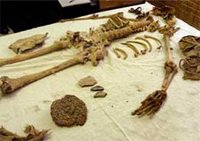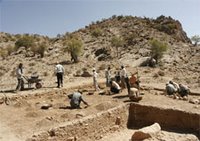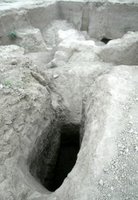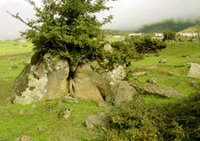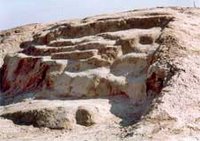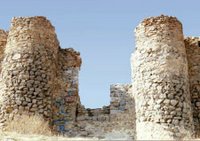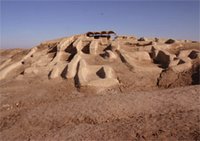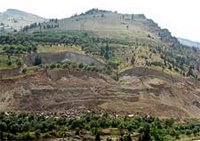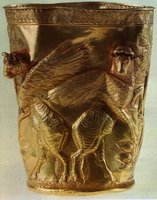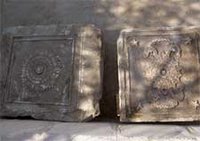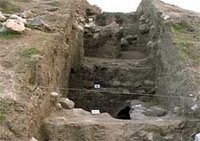
Tehran, 16 January 2006 (CHN) -- Archeological diggings in southern Barzan in south of Persepolis which originally started with the aim of finding early Achaemenid clays, resulted in the discovery of a residence area which dates back to the second millennium BC. How the Achaemenid dynasty came to power and took the control within its domain is still a matter of controversy. Since archeologists were unable to find any clay relics from the beginning of the Achaemenid era, the time of
Cyrus and Cambyses reigns has remained a mystery.
“The famous Timuran clay, identified and categorized by an archeologist named Wanderburg, is one of the most important clays found in the area. This clay relic dates back to the Elamite to the Parthian eras and was discovered in Marvdasht near
Persepolis historical site. Archeologists believe that this kind of clay was made by the local people in second millennium BC. After that, Timuran clays were not produced any longer until the Achaemenids came to power,” said Kamyar Abdi, Iranian archeologist in the United States and head of the excavation team in southern Barzan.
“Based on historical evidence, Achaemenid dynasty came to power around 550 BC in Fars, but there is no evidence on the way in which they come to power. We do not know what happened in the region between the years 800 to 550 BC which led to the stopping of the production of the prominent clay of the Elamite era and a historical standstill took place until the empowerment of the Achaemenid dynasty in the region,” added Abdi.
Based on archeological excavations in Tal e Timuran, Wanderburg studied the Timuran clays concluded that they belong to two distinct groups, namely Timuran A and Timuran B. The clays of the Elamite era are categorized in the Timuran A, and the characteristics of the clays unearthed in Central Plateau and places such as Gudin Tepe and Hasan Lu belong to the Timuran B group. Wanderburg carried out some excavations in the north of Persepolis in Jalabad area and discovered some clays there which were similar to those of the Sialk cemetery.
Considering Wanderburg’s discoveries, Abdi explained, “We believe that Timuran A clay was the prominent clay made during the Elamite era in the region. Later, between the years 800 and 550 BC, some kind of clay was imported to the area from the Central Plateau which caused changes in the forms of these clays and ultimately raised new questions. Something that has still remained a mystery is the shape of the clays of the beginning of Achaemenid era.”
According to Abdi, the discovered clays in Pasargadae historical site belong to the end of the Achaemenid dynasty, which means the time of Alexander’s attack to Persepolis, and have no relations to
Cyrus’ era.
“Between the years 1967 and 1973, another archeologist, Akbar Tajvidi, unearthed some dwellings in southern Barzan. In his report Tajvidi says that after passing the sedimentary layers he was faced with a residential area in which a kind of clay was discovered which was different with those of the Achaemenid era. However, he did not give any further explanations about this clay in his report, and thus we do not have any information about the way this clay looked like. Therefore, we concluded that the sedimentary layers were the foundations of the Achaemenid castle and that the clay he had found most probably belonged to the Cyrus and Cambyses eras,” explained Abdi.
With this conception, the archeologists started excavations in southern Barzan by digging a 3 by 2 meter trench to study the area.
“The sedimentary layers that Tajvidi mentioned in his report were in fact natural sediments formed over the course of a thousand years. After removing these layers we faced the “Golbeie” clays which belong to 4000 years ago, contrary to what we had previously anticipated. Most probably these clays belong to some settlements from this period near Persepolis which have remained unknown so far. Although we discovered these clays, since they were not what we were looking for, we are going to continue our excavations to discover some clays belonging to the beginning of the Achaemenid era,” explained Abdi about the result of the excavations.
According to the historical evidence, there used to be a city called Matezish near
Persepolis historical site, from which nothing has remained. This city was a residential area during the Elamite and maybe Achaemenid eras. It is not clear yet what happened to this city after the Elamite period. However, for sure it existed during the ancient times and it might have been in located in the present-day Barzan or Firuzi cities or the perhaps the west of Persepolis.
